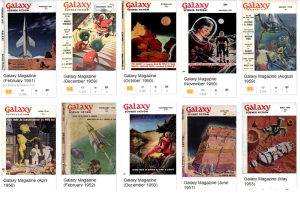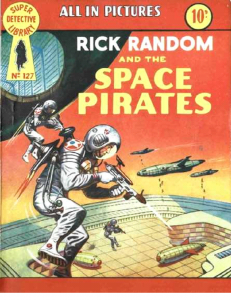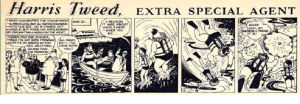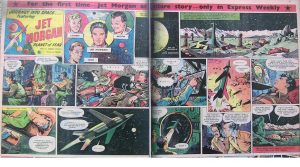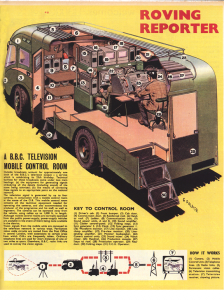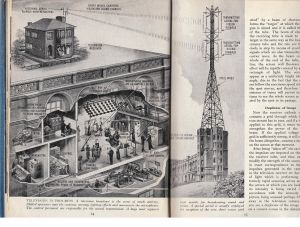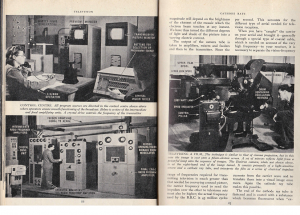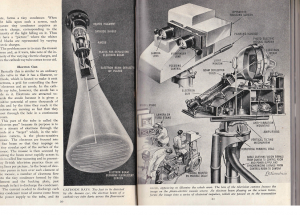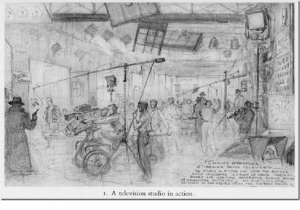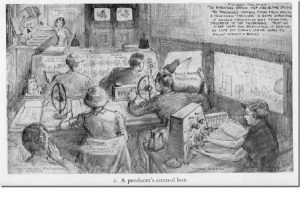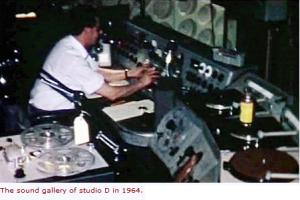Bernie Newnham
If anyone likes a bit of old style science fiction, here is Galaxy for free – https://archive.org/details/galaxymagazine&tab=collection
(Click on the picture below to see larger version:
use your Browser’s BACK button to return to this page)
Graeme Wall
Wow!
Roger Bunce
I was about to ask if anyone, apart from me, remembers Rick Random: Space Detective? – because last time I searched for him on the Internet, there was no trace. But now the web seems to have rediscovered him!
(Click on the picture below to see larger version:
use your Browser’s BACK button to return to this page)
David Brunt
There’s a very chunky book reprint of ten of the stories.
https://www.amazon.co.uk/Rick-Random-Detective-Adventure-Picture/dp/1853756733/
Dave Mundy
Any one got “Eagle” or “Lion” comics? They were all the rage in my 12-15 years (plus Ian Allan Locospotters’ books!). And yes, I had “Hotspur”, “Dandy”, “Rover”, and “Wizard” – who didn’t?
Alec Bray
Those who had “Beano” and Biffo the Bear …
Graeme Wall
I’ve got a book of the “Eagle” cutaway drawings and a “biography” of Dan Dare!
Pat Heigham
I’m sure that you all remember “The Forbidden Planet” (1956 film)
Later there was a stage show: “Return to the Forbidden Planet”. Similar to the original, it was loosely based on “The Tempest” and I regarded it as Shakespeare collides with Rock’n’Roll.
I was booked to record the show at the Cambridge Theatre with two cameras, for an American client. He was only supposed to take a ten-minute extract, but we recorded the whole show.
I was linked to the PA desk for the audio, and it was so well choreographed, that where speech had to be enhanced, there was a mic. No radio mics apart from the one on the Robot. I only mention all this as the ‘Captain’ was a dead ringer for Dan Dare!
(There was a nasty taste afterwards, as I was charged to obtain a cheque from the US ‘producer’ before I handed over the tapes. This was promised, ‘… as we might be shooting in London on Monday…’.
On the phone to my booker, at midnight, I was instructed to give him the tapes. He buggered off back to the States, and never paid. I just hope that his name was broadcast far and wide, never anyone to work for the blighter again!)
Alec Bray
The “Eagle” had a strip cartoon “Harris Tweed” – story and drawings by John Ryan. I always liked Harris Tweed, so it was a joy later to work on “Captain Pugwash” – and real-time animation! Harris Tweed had a capable boy sidekick, just like Pugwash.
(Click on the picture below to see larger version:
use your Browser’s BACK button to return to this page)
Bernie Newnham
In Tufnell Park, when I was growing up, we had paper recycling, just like now. My mother used to package up my “Eagle” comics with string and leave them out to be collected. I would go downstairs and see how many I could extract from the pack without her noticing.
Lots of years later my wife would drag me off to antiques fairs on Sunday afternoons, and to relieve the boredom I started collecting “Eagle” annuals. It was quite difficult to find the early ones, but I now have all up to about number 14. Of course, these days you just go to Amazon where you can pick up any of them for not much money, but that’s not nearly as good as finally finding one in a pile of old books and haggling for it.
Alasdair Lawrance
Ditto about “Eagle” annuals. I stopped at No. 10, and I also have “The Eagle Books of…” Hobbies, Balsa Models, Model Boats, Model Cars, Model Spacecraft.
I don’t know how many of these there were, I only had the ‘Balsa Models’ as a kid.
Roger Bunce
I didn’t have the “Eagle”. Fortunately, my friend next-door did, so I read his. My parents, wanting me to read something more literate than a comic, bought me the “Junior Express”: a children’s newspaper, published by the “Daily Express”. Fortunately, it gradually evolved, losing words and gaining pictures, until it became a glossy Eagle-style comic. Instead of Dan Dare, it had a full-colour, centre-page spread of "Journey into Space – with Jet Morgan", plus Doc, Mitch, Lemmy and the familiar radio characters, in new adventures by Charles Chilton.
I knew I had a not-very-good photo copy somewhere!
(Click on the picture below to see larger version:
use your Browser’s BACK button to return to this page)
Did the “Eagle” ever publish a cutaway illustration of a TV Studio – or even of Television Centre? And why not?!
Graeme Wall
I seem to recall there being something about television in the cutaways in the “Eagle” but it isn’t in my book – which is only a selection.
Bernie Newnham
I thought I had a copy of that book, and it turns out that I do. It’s the one at the very bottom.
(Click on the picture below to see larger version:
use your Browser’s BACK button to return to this page)
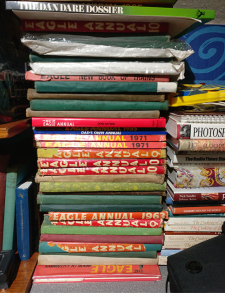
Graeme Wall
That looks like my "library"!
Bernie Newnham
Having wrestled the book from the bottom of the pile, I can say that no TV studio is included, and so I offer this as compensation. It shows how little we’ve progressed in some ways in 64 years.
(Click on the picture below to see larger version:
use your Browser’s BACK button to return to this page)
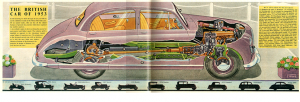
Barry Bonner
And here’s one that some of our colleagues may remember!
(Click on the picture below to see larger version:
use your Browser’s BACK button to return to this page)
BBC Scanner 1953.
Nick Ware
I never collected any boys’ mags, not even grown up ones. But in1957 I was given a book that still fascinates me, and got me interested in all things technical in the first place. It’s “How and Why it Works" pub. Odhams Press in 1948.
Three pictures from it that might be of interest are about TV broadcasting, including a cutaway of an AP studio. (the photos are much reduced, I hope the quality is OK.)
(Click on the pictures below to see larger versions:
use your Browser’s BACK button to return to this page)
You really need to see the book, it’s pretty fabulous.
(I’m happy to let the book do the rounds on loan, as long as I get it back.)
Mike Jordan
If you really want to know the inside information about how TV productions are put together, try this from my 1952 book “The Art of Television” by Jan Bussell – including a shot of her with Mr Muffin.
The book also contains a script completely marked up with camera moves and cuts etc etc.
Bought by me even before my BBC career started.
(Click on the pictures below to see larger versions:
use your Browser’s BACK button to return to this page)
Barry Bonner
I’m intrigued as to how the vision mixer lady sees a monitor!
Mike Giles
I took that to be sound and I presumed the director was doing his own vision mixing – did vision mixers ever have rotary faders?
Pat Heigham
Looks more like the old mixing panel in LG ‘D’ Sound control!
Alec Bray
Studios D and E in Lime Grove – at the time that they had the CPS Emitrons – had rotary Vision Mixing faders. On a quick glance, there was little apparent difference between the sound and vision mixing desks.
Pat Heigham
Didn’t know that!
I worked in my early days in D and E, but on the floor, so perhaps had little knowledge of control room kit.
The first camera that I was allowed to ‘operate’ was the camera on the teleprinter for Grandstand. (CPS Emitron in LG-G). Little operation was required, as it was locked off, but needed to be checked for framing and focus!
I didn’t ever operate a camera before moving to Sound, but had a go at tracking the Vinten motorised, making a huge balls up on a curving track, and mis-positioning on a tracking ladder for the rest of the show.
Unfortunately Jim Atkinson was on the front and I got a fearful wigging!
Think I became better at boom operating!
Tony Briselden
I’m intrigued at the response re rotary faders for vision mixers in D and E. In the late 1950s I vision-mixed several children’s programmes in E and they certainly weren’t rotary. I also believe that the cameras were CPS Emitrons.
So when was the mixer changed I wonder?
Alec Bray
What I remember is this … Sometimes to clean them, and sometimes just for fun to pass the time, we would remove a rotary fader from a mixing desk. The faders were about 6 inches long and about 4 inches diameter, quite hefty, and at the end opposite the knob there was a circle of brass(?) flat stud-like contacts which made the connection to the desk. These studs needed cleaning as I recall.
From the TV Studio History website:
(Click on the picture below to see a larger version:
use your Browser’s BACK button to return to this page)
Now, apart from the obligatory sound training (very useful, no mistake about that!) I was always on the vision side of things, so at breaks would usually be lurking about in the Production Gallery (not the Sound Gallery) – which is why I thought the faders in question were in the vision mixing desk. It might just have been LG ‘D’ – but that was the studio for "Doctor Who" at about this time. Ah well, perhaps it was the Sound Gallery after all …
Pat Heigham
When the rotary (audio) faders got crackly, one had to clean the studs. The best solution was ‘nose grease’! Running one’s finger down the side of your nose picked up enough ‘grease’ to wipe over the studs – worked a treat.
I dunno, do we exude lanolin, perhaps?
Alasdair Lawrance
I’m assuming that’s the outside of your nose…?
Pat Heigham
Yes of course, otherwise it would ‘bogie up’ the sound!
Geoff Fletcher
The grease we all secrete from the sides of our noses is Squalene. For centuries watchmakers used it to lubricate watch gears and cogs.
Ian Hillson
Studio B at AP had a type B sound desk in News days (and probably before!) and during one evening BBC1 news D. Pearson esq., engineer of that parish, was sound mixing. He started to open a fader on cue and the knob came off in his hand. Undeterred, he reached down to his open toolbox, quickly extracted a pair of pliers, and used these to turn up the exposed shaft.
Nick Ware
Good job he was an engineer then, as we mere technical operators weren’t licensed to carry pliers!
Ian Hillson
You needed a tool box on that windy north London hill – the place was falling apart. It also had a store man who went round collecting all the duff rejected parts from base maintenance bin and putting them back in his stores to save money, which didn’t help.
PBX liked to save money too – they dialled the outside line for you and put you through. After three minutes they came across the line and said "FINISHED?" and again after six minutes (even louder) if you hadn’t. One evening during BBC2 Newsroom we were taking a live telephone report from some correspondent in a far off trouble spot, when (you guessed it!), three minutes into it the above happened – they were a bit more gentle with us all after that!
And back to the pictures …
Mike Jordan
The labels are correct!
Vision only had 2 cameras and it was a simple mix between the 2 or another separate fade to black.
I won’t go into technicalities but in early days, as I understand it, there was no such thing as timing between cameras so having more than 2 would have been difficult. As it was, the fader was rotary with one camera fed in at each end of the fader and the sync pulses changed by a relay off a contact in the centre position.
I have a full description in my copy of the 1937 AP Technical handbook if you really really want more information!
Chris Woolf
Well… I’m not sure that can be right.
In the bad old days sync pulse generation was never in the camera – it was always central to a studio, and distributed as separate line and field drives, blanking, sync etc to each camera control. This was much simpler than trying to produce syncs within a camera channel. Thus all cameras within a studio complex were inherently "timed", though there might be some lateral picture displacement due to cable length differences.
Right at the outset (1934) EMI had a vision mixer capable of 6 channels (four Emitron cameras and two TKs), and demonstrated that to the BBC in Hayes. So mixing started with the first Emitrons.
Sync timing, and hence the ability to mix (or cut without a picture roll) only became a significant problem with multiple studios and outside broadcasts.
Mike Giles
I had only looked at the pictures on the phone and didn’t notice the labels – which leads to another question – why has the vision mixer got half a dozen faders for two cameras?


